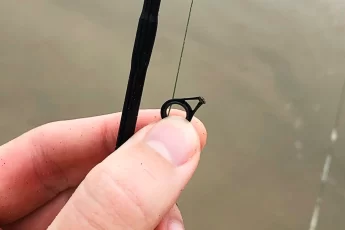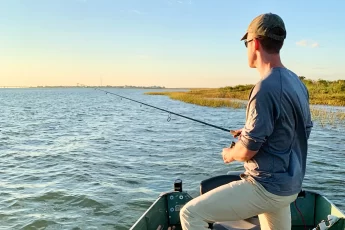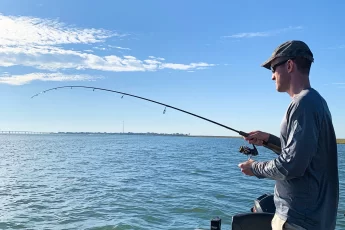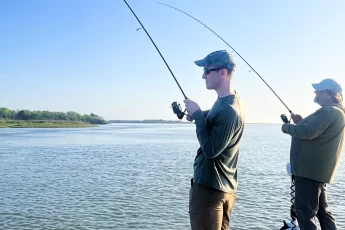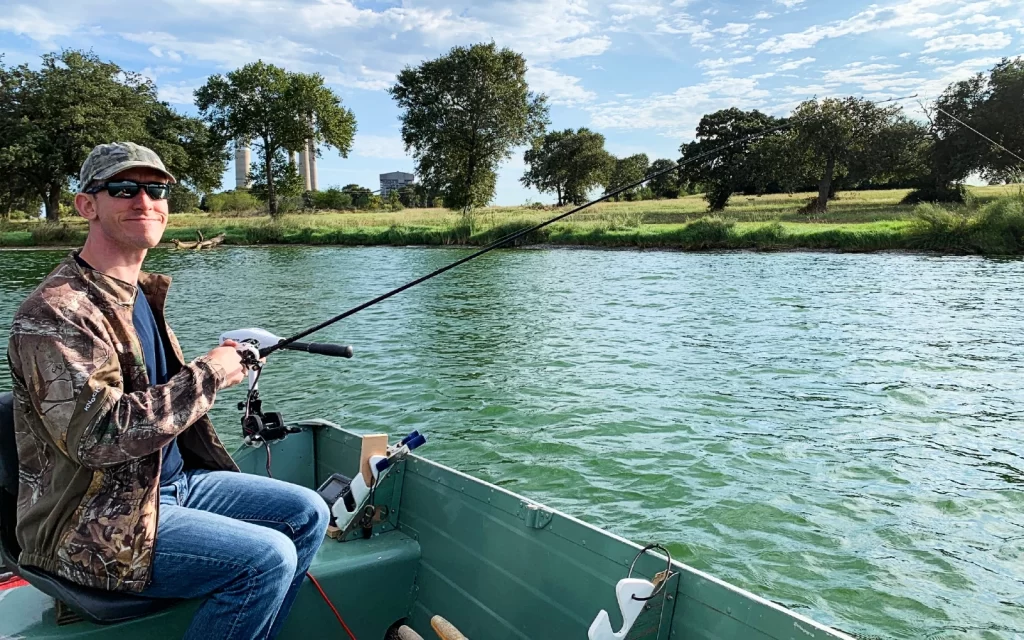
Updated 2/13/2024
Jig fishing for bass is a technique that utilizes a skirted jig head with a soft plastic trailer to target bass around a huge range of cover like thick matted grass, weed beds, submerged wood, or deep rock piles. The best jig rods for bass fishing this wide array of structure need to be versatile, sensitive, and tough to give anglers the best shot at catching the most bass.
We’ve done the hours of testing and research on the best jig rods for bass available assessing strength, value for the price, material quality, fishing comfort and much more so you don’t have to. Read on to see our top picks.
*Disclosure: I only recommend products I would use myself and all opinions expressed here are my own. This post may contain affiliate links that at no additional cost to you, I may earn a small commission.
Our Top Picks
- Best for the Money: St. Croix Mojo Bass Casting
- Most Sensitive: St. Croix Victory Casting Rod
- Best Under $100: KastKing Perigee II Casting
- Best for Beginners: Lew’s American Hero Speed Stick Casting Rod
- Best Spinning: Penn Battalion II Inshore Spinning Rod
The Best Jig Rods for Bass
The best jig rods for bass depend on factors like the type of vegetation you’re fishing near, target water depth, and budget.
Read on to see our recommendations for the best jig rods for bass by category including best for the money, best budget, best for beginners, and more.
1. St. Croix Mojo Bass Casting
- Length: 6’8″ to 7’11”
- Rod Material: SCIII Carbon
- Guides: Kigan Master Hand 3D guides with Aluminum Oxide Rings
- Grip: Split premium cork grip
- Warranty: 5 Year
Pros:
- Great variety in available length, power, and action
- Premium rod at manageable price
- Excellent Warranty
Our choice for best jig rod for bass for the money is the St. Croix Mojo Bass Casting Rod. We have found this rod line to be the perfect balance of quality components, versatility, and price point.
What sold us on this rod for the top choice is how much value you get for the price. Other rods on this list may be slightly lighter or more sensitive, but generally their price point will be significantly higher. We’re suckers for a great deal and realistically would be happy if every bass pole in our collection was a St. Croix Mojo Bass.
The Mojo Bass Casting comes in the perfect spread of lengths, powers, and actions. A great choice for a fishing rod is the 7’1″ medium-heavy power fast action variant.
This rod line was updated in 2016. The rod blank is St. Croix’s proprietary SC III graphite fiber which is lightweight, durable, and sensitive with a higher strain rate than fibers commonly used by other rod manufacturers. It also includes St. Croix’s innovative IPC tooling technology that effectively eliminates transition points in the rod. The Mojo Bass rod line is on the lighter end of available bass rods with superior sensitivity without sacrificing strength.
2. St. Croix Victory Casting Rod
- Length: 6’8″ to 7’11”
- Rod Material: SCIII+ Carbon
- Guides: Fuji Concept O guides with deep press inserts
- Grip: Split premium cork grip
- Warranty: 15 Year Transferrable
Pros:
- Premium rod at manageable price
- Excellent Warranty
Our pick for the most sensitive jig rod for bass is the St. Croix Victory Casting Rod. We particularly like the 7’3″, medium-heavy power, fast action variant for jig fishing for bass.
St. Croix has crafted one of the lightest, strongest, most sensitive jig rods for bass available on the market.
The rod features four of St. Croix’s innovative technologies.
Integrated Poly Curve (IPC) eliminates all transitional points in the rod blanks for smoother actions, increased strength, and greater sensitivity.
Advanced Reinforcing Technology (ART) is an exotic carbon fiber material that adds a magnitude (10x) of strength with virtually no increase in rod blank diameter or weight and significantly improves the hoop strength of the blank by preventing it from deforming under severe loads (like the donkey bass you pull out of the slop)!
The Taper Enhancement (TET) blank design provides curved patterns for improved action and sensitivity.
And last but not least, rods manufactured with the Fortified Resin System (FRS) advanced manufacturing protocol consistently test 33% stronger than those built with standard resins and curing methods.
Also, St. Croix manufactures their high-end rod lines in Wisconsin for United States based anglers looking to support local manufacturing.
3. KastKing Perigee II
- Length: 4’6″ to 7’6″
- Rod Material: Carbon Fiber
- Guides: Fuji O-Ring
- Grip: Split EVA Foam
- Warranty: Lifetime manufacturing defects only for handling fee. Lifetime accidental damage for 1/2 rod price plus handling fee.
Pros:
- Budget friendly
Don’t let the low price fool you. KastKing’s Perigee II fishing rod line provides surprising quality at a budget price which makes it our choice for best jig rod for bass under $100.
We recommend the 7’4″ heavy power and the 7’6″ medium-heavy power casting versions of this rod for awesome budget bass jig fishing rods.
This rod is a breath of fresh air in the budget fishing space. A full carbon fiber blank keeps weight low and sensitivity high.
As expected with budget rod options there is some give and take on features. The split EVA handle doesn’t feel as good as cork handles on some of the higher end rods in this list. Also, we would like the option for lengths closer to 8′ for taller jig anglers that want to flip and pitch.
For other great options check out our article on the best bass rods under $100.
4. Lew’s American Hero Speed Stick Heavy Casting Rod
- Length: 6′ to 7’6″
- Rod Material: IM7 Graphite
- Guides: Stainless steel guides with stainless steel inserts
- Grip: Split EVA Foam
- Warranty: 1 Year manufacturing defects
Pros:
- Budget Friendly
- Versatile for multiple fishing techniques
Our choice for best jig rod for bass for beginners is the Lew’s American Hero Speed Stick 7’6″ Heavy Flipping Casting Rod. For beginners, we focus on budget and versatility. We think anglers should start with a middle-tier rods that can be used for many techniques before purchasing high-end, specialized equipment.
The 7’6″ heavy power Lew’s American Hero Speed stick fits the bill. This rod works for most budgets. The 7’6″ length is on the longer side for all-purpose rods, but can be used for many other techniques like spinnerbaits, crankbaits, etc. We think beginners should get all-purpose rods that work for multiple fishing techniques.
This rod features a sensitive, but strong, graphite blank, stainless steel guides/inserts, and a split foam handle. There aren’t many bells and whistles, but that’s ok. It has the right price and features for an excellent value proposition for a beginner friendly jig rod for bass.
We do note that this is still a casting rod that is paired with a baitcasting reel which can be intimidating for beginners. If not comfortable with casting reels, check out our next entry.
5. Penn Battalion II Inshore Spinning Rod
- Length: 7′ to 8′
- Rod Material: SLC2 Carbon
- Guides: Fuji Alconite
- Handle: Premium Cork or Rubber Shrink Tube
- Warranty: 1 Year manufacturing defects only
Pros:
- Highly versatile for multiple fishing applications
- Premium rod features for reasonable price
Our top choice for best jig spinning rod for bass is the Penn Battalion II Inshore Rod. This rod captures a great balance of value, price accessibility, and quality features.
It may seem like a strange choice to pick an inshore fishing rod for a bass technique. The challenge with jig fishing is that it can require long, sturdy, heavier power rods, and most freshwater spinning rigs don’t go above medium power.
We picked an inshore rod as our top spinning jig rod because inshore rods are designed for bigger fish. This translates perfectly to the power needed for ripping big bass out of heavy cover.
We recommend the 7’6″ medium-heavy power or the 7′ heavy power version for this application.
The SLC2 Carbon rod blank and Fuji Alconite guide material construction are considered mid-tier materials that should last plenty long with proper care. The full cork handle feels great for prolonged fishing trips. We do wish Penn offered a better warranty (like St. Croix), but it’s hard to complain at this price point.
If you must have a spinning jig rod, this is a great option. That said, we still recommend learning how to use a baitcasting setup for this fishing technique because it is easier to accurately cast compared to a spinning setup.
Check out our article on the best bass spinning rods for additional options.
Rod Comparison Table
Check out our handy comparison table showing key specifications for our top rod choices.
| Rod Name | Length | Rod Material | Guides | Grip | Warranty |
|---|---|---|---|---|---|
| St. Croix Mojo Bass Casting | 6’8″ to 7’11” | SCIII Carbon | Kigan Master Hand 3D guides with Aluminum Oxide Rings | Split premium cork grip | 5 Year |
| St. Croix Victory Casting Rod | 6’8″ to 7’11” | SCIII+ Carbon | Fuji Concept O guides with deep press inserts | Split premium cork grip | 15 Year Transferrable |
| KastKing Perigee II | 4’6″ to 7’6″ | Carbon Fiber | Fuji O-Ring | Split EVA Foam | Lifetime manufacturing defects only for handling fee. Lifetime accidental damage for 1/2 rod price plus handling fee. |
| Lew’s American Hero Speed Stick Heavy Casting Rod | 6′ to 7’6″ | IM7 Graphite | Stainless steel guides with stainless steel inserts | Split EVA Foam | 1 Year manufacturing defects |
| Penn Battalion II Inshore Spinning Rod | 7′ to 8′ | SLC2 Carbon | Fuji Alconite | Premium Cork or Rubber Shrink Tube | 1 Year manufacturing defects only |
Conclusion
The best jig fishing rods for bass need to be sensitive, versatile, and reliable to handle the demands of targeting bass in various types of cover. The St. Croix Mojo Bass is our top choice due to its great selection of powers, lengths, and actions plus its quality components and reasonable price point.
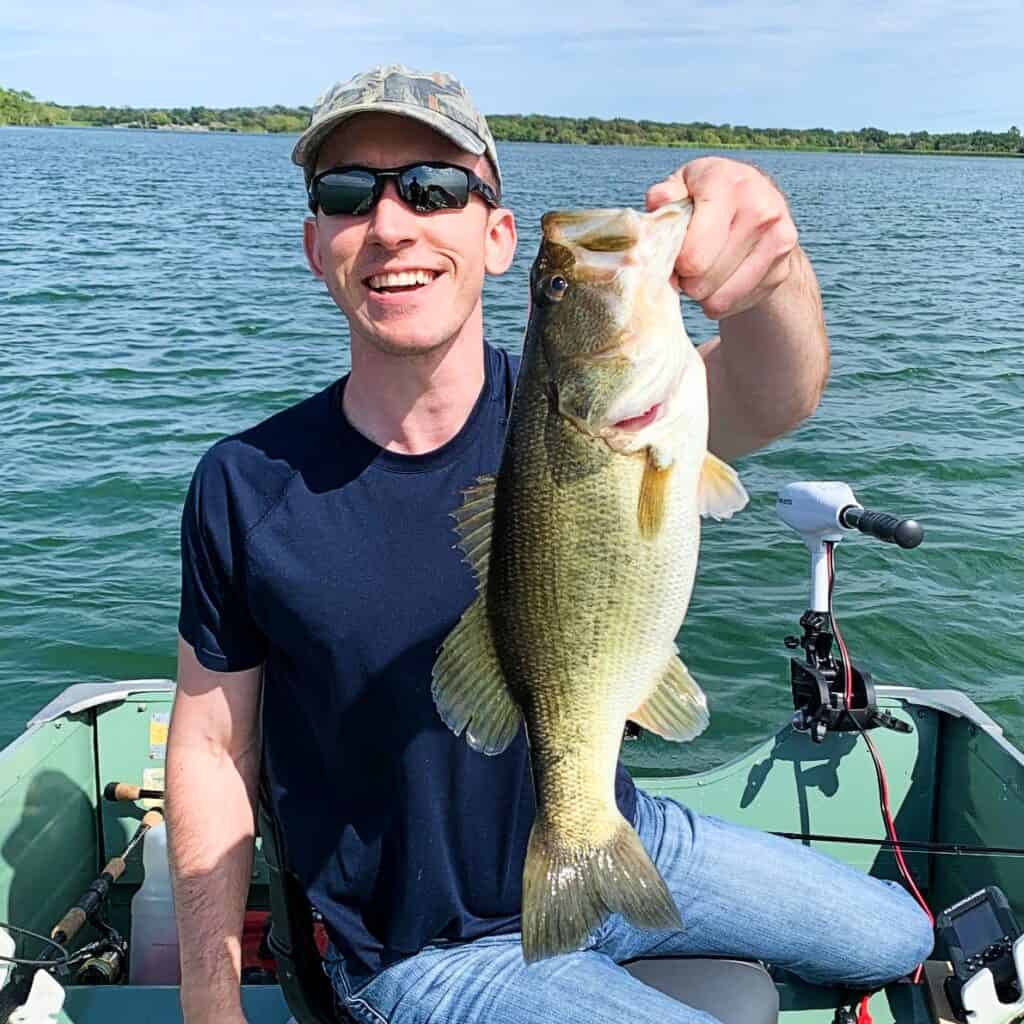
Check out our articles for great reels to pair with these rods:
Check out our related rod articles:
- Best Bass Fishing Rods
- Best Bass Baitcasting Rods
- Best Bass Spinning Rods
- Best Smallmouth Bass Rods
- Best Musky Rods
- Best Frog Fishing Rods
- Best Walleye Rods
Check out our related rod and reel combo articles:
Read on to see our breakdown of important factors to consider when picking a jig rod for bass fishing.
How to Choose The Best Jig Rod for Bass
The most important factors for selecting the best jig rod for bass are rod length, action, and power.
For even more reading, check out our article on how to choose any fishing rod.
Length
Jig rods for bass need enough length to handle a variety of casting distances without being too long that they’re unwieldy. For accurately casting into thick weeds or vegetation, shorter rods closer to 6’6″ allow for the most precise casts. If flipping, pitching, or punching jigs, rods between 7’6″ and 8′ allow for the most comfortable casting. For football jigs in situations where the angler wants to cover tons of water, 7’6″ is a great length for long casts.
If in doubt, our recommendation is bass rods between 7′ and 7’6″ are great all-around lengths that perfectly balance casting distance and accuracy.
Power
Rod power is the fishing industry’s terminology for rod stiffness. Rod powers range from ultralight to extra-heavy.
Medium to heavy power rods are the bread and butter of the bass jig fishing world. If flipping, pitching, or punching heavy cover, the rod needs to be able to rip large bass out of the thickest, nastiest weeds and a heavy power is warranted. If fishing open water without tons of vegetation, medium to medium-heavy power is a good option.
Action
Rod action refers to how far down the rod will bend when pressure is applied to the tip. Rod actions range from extra-fast (bends near tip) to slow (nearly the whole rod bends).
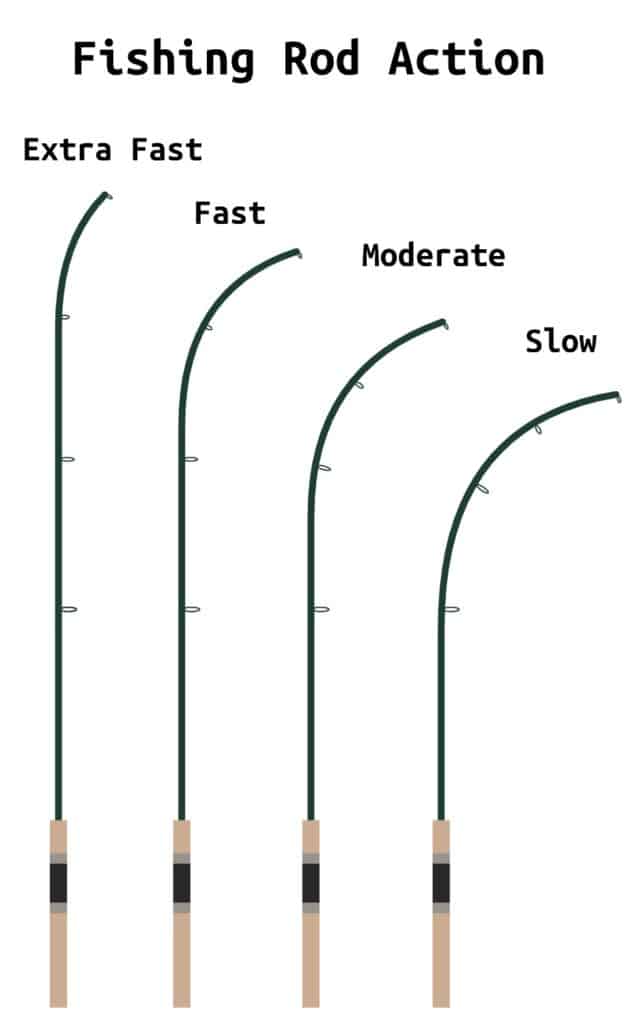
The faster the action, the more sensitive the rod will feel. The slower the action, the more casting distance you can get (the rod will feel like it whips more when you cast).
Bass jig anglers lean towards fast or extra-fast actions because these actions have the most sensitivity and translate powerful hooksets most quickly to the fish.
Check out our article on fishing rod actions for even more information.
Handle Material
Rod handle feel is an important factor to consider when picking a bass fishing rod. Common handle types are full cork, partial cork, rubber shrink tube, cork tape, or EVA foam. Rubber shrink is usually considered a more budget option, whereas full cork feels better to grip and handle. Jig fishing for bass can require forceful hooksets, EVA foam can be a better option because it is not slippery when wet.
Rod Guide Material
Rod guide material is important because lower quality materials are heavier and will rust quicker and could potentially fail.
The highest end rods have titanium or silicone carbide (SiC) rod guides whereas middle end or budget rods will have some variation of aluminum oxide or stainless steel.
Higher end rod guides are made with lighter materials with lower friction that will either rust slower or not at all. Less expensive rod guides are heavier and will succumb to the elements more quickly.
For additional information on rod guide considerations, check out our article that explains fishing rod guides in detail.
Rod Material
Rod blank material affects rod strength and how the fishing rod deforms during casting or reeling in a fish. Common rod materials are graphite, fiberglass, and composite. Check out our deep dive on rod blanks for more information.
Graphite
Graphite rods have incredible sensitivity in lightweight packages. They are great for detecting subtle fish strikes. Graphite rod disadvantages are that the rods can be a little weaker than the other options and more susceptible to breakage, especially around nicks or scratches.
Fiberglass
Fiberglass is strong, durable and flexible but weighs more than graphite. They are less sensitive than the other types of rod materials.
Composite
Composite rod materials are a mix of graphite and fiberglass that seek to have the light weight and sensitivity of graphite rods with the strength of fiberglass rods.
Reel Seat
Reel seats are the component where the fishing reel is secured onto the fishing rod by tightening a locking nut. The basic parts of a reel seat are the body, hood, locking nut, and barrel threads. Common reel seat materials are either graphite or aluminum which are both lightweight, corrosion resistant materials. Reel seats are sized to match the power of the rod. For example, a reel seat on an ultralight fishing rod won’t fit a massive 10000 size spinning reel.
Most freshwater applications utilize fully graphite reel seats due to graphite’s light weight. For heavier duty saltwater applications, reel seats are commonly upgraded to machine-grade aluminum for increased strength. For targeting the largest fish on the planet, the complete rod butt and reel seat can be aluminum for maximum strength.
Maintenance and Care
Maintaining your fishing rod ensures its longevity and performance. After each use, rinse it with fresh water to remove dirt and debris, especially if you’ve been fishing in saltwater. Dry it thoroughly before storage to prevent rust and corrosion. Occasionally check for any signs of wear or damage. Store your rod vertically or horizontally on a rack, avoiding extreme temperatures or direct sunlight.
Explore our ultimate guide on fishing rod maintenance and care for comprehensive insights into maintaining your bass jig fishing rod, avoiding common causes of damage, and mastering preventative strategies to ensure your gear remains in prime condition.
Jig Rods for Bass Frequently Asked Questions
What type of rod is best for jig fishing for bass?
Casting rods between 7′ and 8′ with medium to heavy power are best for jig fishing for bass. Casting rods with casting reels are super accurate and comfortable to cast all day long. Bass anglers targeting bass with jigs in the thickest cover should use heavier power rods to have the backbone to rip fish out of tough weeds. If fishing open water or smaller jigs, anglers can get away with medium power rods.
What reel to pair with jig fishing rod?
Jig rods are best paired with baitcasting reels. These reels are comfortable to function with one hand, which enables the angler to effectively flip or pitch and cast accurately. Spinning reels can be used for jig fishing, but are tougher to accurately cast. Check out our article on the best baitcasting reels for our top recommendations.
What pound test line for jig fishing?
If flipping and pitching, 30-65 pound test braided line allows anglers to retrieve fish through the thickest cover. Fishing line for flipping and pitching needs to be strong enough to cut through lily pad stems and other thick vegetation. If fishing in more open water, 20 pound braid is a great balance of strength and small diameter.
When should I fish a jig for bass?
Jig fishing for bass can work year-round. The going wisdom is jig fishing deeper water is effective in summer and winter when baitfish are offshore. Jig fishing shallower water in the spring and fall near shallow cover like rocks, stumps, docks, and vegetation can also be super consistent.
What is the most sensitive jig rod?
Graphite rods are considered the most sensitive jig rods due to their light weight and feel in-hand. Jig anglers looking to maximize sensitivity should also look for fast or extra-fast rod actions because they transmit the vibrations from fish strikes or running over cover the best.

Written By: Andrew Juran
Andrew is a seasoned angler with over 25 years of experience fishing across the United States. He has caught hundreds of bass using various techniques and mentored many in the art of fishing. An advocate for sustainable fishing, Andrew is an active member of the Coastal Conservation Association, an organization committed to marine conservation.
For frequent fishing tips, behind-the-scenes looks, and real-time catches, connect with Andrew on Instagram







